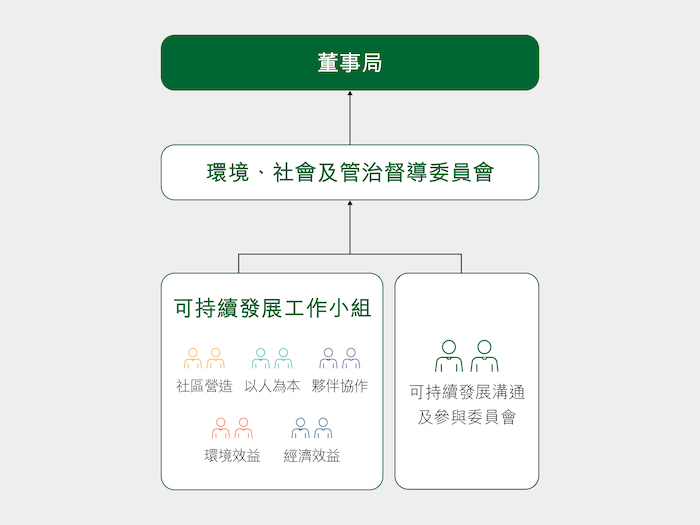國際財務報告準則可持續披露準則第2號 ― 氣候相關披露索引
我們參照國際可持續準則理事會(ISSB)於2023年6月發表的《國際財務報告準則可持續披露準則第2號 — 氣候相關披露》增設內容索引。
(僅提供英文版)
滑動或拖曳圖表瀏覽
Disclosure Description | References and Remarks |
|---|---|
Governance (5) The objective of climate-related financial disclosures on governance is to enable users of general purpose financial reporting to understand the governance processes, controls and procedures used to monitor and manage climate-related risks and opportunities. 6(a) To achieve this objective, an entity shall disclose information about the governance body(s) (which can include a board, committee or equivalent body charged with governance) or individual(s) responsible for oversight of climate-related risks and opportunities. Specifically, the entity shall identify that body(s) or individual(s) and disclose information about: | |
(i) how responsibilities for climate-related risks and opportunities are reflected in the terms of reference, mandates, role descriptions and other related policies applicable to that body(s) or individual(s); | SD Governance Climate-related Financial Disclosures Performance (Economic) Annual Report 2023 – Corporate Governance Annual Report 2023 – Risk Management Corporate website – Terms of Reference for Environmental, Social and Governance Steering Committee Corporate website – Climate Change Policy |
(ii) how the body(s) or individual(s) determines whether appropriate skills and competencies are available or will be developed to oversee strategies designed to respond to climate-related risks and opportunities; | Climate-related Financial Disclosures Annual Report 2023 – Corporate Governance |
(iii) how and how often the body(s) or individual(s) is informed about climate-related risks and opportunities; | SD Governance Climate-related Financial Disclosures |
(iv) how the body(s) or individual(s) takes into account climate-related risks and opportunities when overseeing the entity’s strategy, its decisions on major transactions and its risk management processes and related policies, including whether the body(s) or individual(s) has considered trade-offs associated with those risks and opportunities; and | SD Governance Climate-related Financial Disclosures Performance (Economic) |
(v) how the body(s) or individual(s) oversees the setting of targets related to climate-related risks and opportunities, and monitor progress towards targets, including whether and how related performance metrics are included in remuneration policies. | SD Governance Performance (Environment) Climate-related Financial Disclosures Performance (Economic) 2025 & 2030 Targets Corporate website – Terms of Reference for Environmental, Social and Governance Steering Committee Corporate website – Terms of Reference for Remuneration Committee Corporate website – Remuneration Policy |
6(b) management’s role in the governance processes, controls and procedures used to monitor, manage and oversee climate-related risks and opportunities, including information about: | |
(i) whether the role is delegated to a specific management-level position or management-level committee and how oversight is exercised over that position or committee; and | SD Governance Climate-related Financial Disclosures Performance (Economic) Annual Report 2023 – Risk Management |
(ii) whether management uses controls and procedures to support the oversight of climate-related risks and opportunities and, if so, how these controls and procedures are integrated with other internal functions. | SD Governance Climate-related Financial Disclosures Performance (Economic) Annual Report 2023 – Risk Management |
Strategy (8) The objective of climate-related financial disclosures on strategy is to enable users of general purpose financial reporting to understand an entity’s strategy for managing climate-related risks and opportunities. | |
9(a) the climate-related risks and opportunities that could reasonably be expected to affect the entity’s prospects; | See the reference for paragraph 10 |
9(b) the current and anticipated effects of those climate-related risks and opportunities on the entity’s business model and value chain; | See the reference for paragraph 13 |
9(c) the effects of those climate-related risks and opportunities on the entity’s strategy and decision-making, including information about its climate-related transition plan; | See the reference for paragraph 14 |
9(d) the effects of those climate-related risks and opportunities on the entity’s financial position, financial performance and cash flows for the reporting period, and their anticipated effects on the entity’s financial position, financial performance and cash flows over the short, medium and long term, taking into consideration how those climate-related risks and opportunities have been factored into the entity’s financial planning; and | See the reference for paragraph 15 |
9(e) the climate resilience of the entity’s strategy and its business model to climate-related changes, developments and uncertainties, taking intoconsideration the entity’s identified climate-related risks and opportunities. | See the reference for paragraph 22 |
Climate-related risks and opportunities (10) An entity shall disclose information that enables users of general purpose financial reporting to understand the climate-related risks and opportunities that could reasonably be expected to affect the entity’s prospects. Specifically, the entity shall: | |
10(a) describe climate-related risks and opportunities that could reasonably be expected to affect the entity’s prospects; | Performance (Environment) Climate-related Financial Disclosures Performance (Economic) Annual Report 2023 – Risk Management |
10(b) explain, for each climate-related risk the entity has identified, whether the entity considers the risk to be a climate-related physical risk or climate-related transition risk; | |
10(c) specify, for each climate-related risk and opportunity the entity has identified, over which time horizons - short, medium or long term - the effects of each climate-related risk and opportunity could reasonably be expected to occur; and | |
10(d) explain how the entity defines ‘short term’, ‘medium term’ and ‘long term’ and how these definitions are linked to the planning horizons used by the entity for strategic decision-making. | |
Business model and value chain (13) An entity shall disclose information that enables users of general purpose financial reports to understand the current and anticipated effects of climate-related risks and opportunities on the entity’s business model and value chain. Specifically, the entity shall disclose: | |
13(a) a description of the current and anticipated effects of climate-related risks and opportunities on the entity’s business model and value chain; and | Partners Performance (Environment) Climate-related Financial Disclosures Performance (Economic) |
13(b) a description of where in the entity’s business model and value chain climate-related risks and opportunities are concentrated. | |
Strategy and decision-making (14) An entity shall disclose information that enables users of general purpose financial reporting to understand the effects of climate-related risks and opportunities on its strategy and decision-making. Specifically, the entity shall disclose: | |
14(a) information about how the entity has responded to, and plans to respond to, climate-related risks and opportunities in its strategy and decision-making, including how the entity plans to achieve any climate-related targets it has set and any targets it is required to meet by law or regulation. Specifically, the entity shall disclose information about: | |
(i) current and anticipated changes to the entity’s business model, including its resource allocation, to address climate-related risks and opportunities; | Partners Performance (Environment) Climate-related Financial Disclosures Performance (Economic) Annual Report 2023 – Key Business Strategies Annual Report 2023 – Risk Management |
(ii) current and anticipated direct mitigation and adaptation efforts; | |
(iii) current and anticipated indirect mitigation and adaptation efforts; | Partners Performance (Environment) |
(iv) any climate-related transition plan the entity has, including information about key assumptions used in developing its transition plan, and dependencies on which the entity’s transition plan relies; and (v) how the entity plans to achieve any climate-related targets, including any greenhouse gas emissions targets, described in accordance with paragraphs 33–36. | SD Governance Partners Performance (Environment) Climate-related Financial Disclosures Performance (Economic) |
14(b) information about how the entity is resourcing, and plans to resource, the activities disclosed in accordance with paragraph 14(a). 14(c) quantitative and qualitative information about the progress of plans disclosed in previous reporting periods in accordance with paragraph 14(a). | SD Governance Partners Performance (Environment) Climate-related Financial Disclosures Performance (Economic) |
Financial position, financial performance and cash flows (15) An entity shall disclose information that enables users of general purpose financial reporting to understand: | |
15(a) the effects of climate-related risks and opportunities on the entity’s financial position, financial performance and cash flows for the reporting period (current financial effects); 15(b) the anticipated effects of climate-related risks and opportunities on the entity’s financial position, financial performance and cash flows over the short, medium and long term, taking into consideration how climate-related risks and opportunities are included in the entity’s financial planning (anticipated financial effects). | Climate-related Financial Disclosures Performance (Economic) |
(16) Specifically, an entity shall disclose quantitative and qualitative information about: | |
16(a) how climate-related risks and opportunities have affected its financial position, financial performance and cash flows for the reporting period; 16(b) the climate-related risks and opportunities identified in paragraph 16(a) for which there is a significant risk of a material adjustment within the next annual reporting period to the carrying amounts of assets and liabilities reported in the related financial statements; | Climate-related Financial Disclosures Performance (Economic) |
16(c) how the entity expects its financial position to change over the short, medium and long term, given its strategy to manage climate-related risks and opportunities, taking into consideration: (i) its investment and disposal plans (for example, plans for capital expenditure, major acquisitions and divestments, joint ventures, business transformation, innovation, new business areas, and asset retirements), including plans the entity is not contractually committed to; and (ii) its planned sources of funding to implement its strategy; and | Climate-related Financial Disclosures Performance (Economic) Annual Report 2023 – Key Business Strategies Annual Report 2023 – Management Discussion & Analysis |
16(d) how the entity expects its financial performance and cash flows to change over the short, medium and long term, given its strategy to manage climate-related risks and opportunities. | Climate-related Financial Disclosures |
Climate resilience (22) An entity shall disclose information that enables users of general purpose financial reporting to understand the resilience of the entity’s strategy and business model to climate-related changes, developments and uncertainties,taking into consideration the entity’s identified climate-related risks and opportunities. The entity shall use climate-related scenario analysis to assess its climate resilience using an approach that is commensurate with the entity’s circumstances. In providing quantitative information, the entity may disclose a single amount or a range. Specifically, the entity shall disclose: | |
22(a) the entity’s assessment of its climate resilience as at the reporting date, which shall enable users of general purpose financial reports to understand: | |
(i) the implications, if any, of the entity’s assessment for its strategy and business model, including how the entity would need to respond to the effects identified in the climate-related scenario analysis; | Performance (Economic) Climate-related Financial Disclosures |
(ii) the significant areas of uncertainty considered in the analysis of climate resilience; | Climate-related Financial Disclosures |
(iii) the entity’s capacity to adjust or adapt its strategy and business model to climate change over the short, medium and long term, including: (1)the availability of, and flexibility in, the entity’s existing financial resources to respond to the effects identified in the climate-related scenario analysis, including to address climate-related risks and to take advantage of climate-related opportunities; (2)the entity’s ability to redeploy, repurpose, upgrade or decommission existing assets; and (3)the effect of the entity’s current or planned investments in climate-related mitigation, adaptation or opportunities for climate resilience; and | SD Governance Partners Performance (Environment) Climate-related Financial Disclosures Annual Report 2023 – Management Discussion & Analysis |
22(b) how and when the climate-related scenario analysis was carried out, including: | |
(i) information about the inputs the entity used, including: (1)which climate-related scenarios the entity used for the analysis and the sources of those scenarios; (2)whether the analysis included a diverse range of climate-related scenarios; (3)whether the climate-related scenarios used for the analysis are associated with climate-related transition risks or climate-related physical risks; (4)whether the entity has used, among its scenarios, a climate-related scenario aligned with the latest international agreement on climate change; (5)why the entity decided that its chosen climate-related scenarios are relevant to assessing its resilience to climate-related changes, developments or uncertainties; (6)the time horizons the entity used in the analysis; and (7)what scope of operations the entity used in the analysis; | Climate-related Financial Disclosures |
(ii) the key assumptions the entity made in the analysis, including assumptions about: (1)climate-related policies in the jurisdictions in which the entity operates; (2)macroeconomic trends; (3)national- or regional-level variables; (4)energy usage and mix; and (5)developments in technology; and | Performance (Environment) Climate-related Financial Disclosures |
(iii) the reporting period in which the climate-related scenario analysis was carried out. | Climate-related Financial Disclosures |
Risk management (24) The objective of climate-related financial disclosures on risk management is to enable users of general purpose financial reports to understand an entity’s processes to identify, assess, prioritise and monitor climate-related risks and opportunities, including whether and how those processes are integrated into and inform the entity’s overall risk management process. | |
(25) To achieve this objective, an entity shall disclose information about: 25(a) the processes and related policies the entity uses to identify, assess, prioritise and monitor climate-related risks, including information about: (i)the inputs and parameters the entity uses; | SD Governance Climate-related Financial Disclosures Performance (Economic) Annual Report 2023 – Risk Management |
(ii) whether and how the entity uses climate-related scenario analysis to inform its identification of climate-related risks; | |
(iii) how the entity assesses the nature, likelihood and magnitude of the effects of those risks; | |
(iv) whether and how the entity prioritises climate-related risks relative to other types of risk; | |
(v) how the entity monitors climate-related risks; and | |
(vi) whether and how the entity has changed the processes it uses compared with the previous reporting period; | |
25(b) the processes the entity uses to identify, assess, prioritise and monitor climate-related opportunities, including information about whether and how the entity uses climate-related scenario analysis to inform its identification of climate-related opportunities; and | |
25(c) the extent to which, and how, the processes for identifying, assessing, prioritising and monitoring climate-related risks and opportunities are integrated into and inform the entity’s overall risk management process. | |
Metrics and targets (27) The objective of climate-related financial disclosures on metrics and targets is to enable users of general purpose financial reports to understand an entity’s performance in relation to its climate-related risks and opportunities, including progress towards any climate-related targets it has set, and any targets it is required to meet by law or regulation. | |
28(a) information relevant to the cross-industry metric categories; | See the reference for paragraph 29 |
28(c) targets set by the entity, and any targets it is required to meet by law or regulation, to mitigate or adapt to climate-related risks or take advantage of climate-related opportunities, including metrics used by the governance body or management to measure progress towards these targets. | See the reference for paragraph 33 |
Climate-related metrics (29) An entity shall disclose information relevant to the cross-industry metric categories of: | |
29(a) greenhouse gas emissions - the entity shall disclose: | |
(i) disclose its absolute gross greenhouse gas emissions generated during the reporting period, expressed as metric tonnes of CO2 equivalent, classified as: (1)Scope 1 greenhouse gas emissions; (2)Scope 2 greenhouse gas emissions; and (3)Scope 3 greenhouse gas emissions; | Performance (Environment) ESG Reporting Standards and Principles Performance Data Summary |
(iii) disclose the approach it uses to measure its greenhouse gas emissions including: (1)the measurement approach, inputs and assumptions the entity uses to measure its greenhouse gas emissions; (2)the reason why the entity has chosen the measurement approach, inputs and assumptions it uses to measure its greenhouse gas emissions; and (3)any changes the entity made to the measurement approach, inputs and assumptions during the reporting period and the reasons for those changes; | |
(iv) for Scope 1 and Scope 2 greenhouse gas emissions disclosed in accordance with paragraph 29(a)(i)(1)-(2), disaggregate emissions between: (1)the consolidated accounting group; and (2)other investees excluded from paragraph 29(a)(iv)(1); | |
(v) for Scope 2 greenhouse gas emissions disclosed in accordance with paragraph 29(a)(i)(2), disclose its location-based Scope 2 greenhouse gas emissions, and provide information about any contractual instruments that is necessary to inform users’ understanding of the entity’s Scope 2 greenhouse gas emissions; and | |
(vi) for Scope 3 greenhouse gas emissions disclosed in accordance with paragraph 29(a)(i)(3), disclose: (1) the categories included within the entity’s measure of Scope 3 greenhouse gas emissions, in accordance with the Scope 3 categories described in the Greenhouse Gas Protocol Corporate Value Chain (Scope 3) Accounting and Reporting Standard (2011); and (2) additional information about the entity’s Category 15 greenhouse gas emissions or those associated with its investments (financed emissions); | |
29(b) climate-related transition risks—the amount and percentage of assets or business activities vulnerable to climate-related transition risks; | Climate-related Financial Disclosures |
29(c) climate-related physical risks—the amount and percentage of assets or business activities vulnerable to climate-related physical risks; | Climate-related Financial Disclosures |
29(d) climate-related opportunities—the amount and percentage of assets or business activities aligned with climate-related opportunities; | Climate-related Financial Disclosures |
29(e) capital deployment—the amount of capital expenditure, financing or investment deployed towards climate-related risks and opportunities; | SD Governance Climate-related Financial Disclosures Performance (Economic) |
29(f) internal carbon prices – the entity shall disclose: (i)an explanation of whether and how the entity is applying a carbon price in decision-making; and (ii)the price for each metric tonne of greenhouse gas emissions that the entity uses to assess the costs of its greenhouse gas emissions; | SD Governance Climate-related Financial Disclosures |
29(g) remuneration – the entity shall disclose: (i) a description of whether and how climate-related considerations are factored into executive remuneration; and (ii) the percentage of executive management remuneration recognised in the current period that is linked to climate-related considerations. | SD Governance Performance (Economic) Corporate website – Remuneration Policy Annual Report 2023 – Corporate Governance – Remuneration Committee |
Climate-related targets (33) An entity shall disclose the quantitative and qualitative climate-related targets it has set to monitor progress towards achieving its strategic goals, and any targets it is required to meet by law or regulation, including any greenhouse gas emissions targets. For each target, the entity shall disclose: | |
33(a) the metric used to set the target; | Partners Performance (Environment) Climate-related Financial Disclosures Performance (Economic) 2025 & 2030 Targets Performance Data Summary Assurance Report |
33(b) the objective of the target; | |
33(c) the part of the entity to which the target applies; | |
33(d) the period over which the target applies; | |
33(e) the base period from which progress is measured; | |
33(f) any milestones and interim targets; | |
33(g) if the target is quantitative, whether it is an absolute target or an intensity target; and | |
33(h) how the latest international agreement on climate change, including jurisdictional commitments that arise from that agreement, has informed the target | |
(34) An entity shall disclose information about its approach to setting and reviewing each target, and how it monitors progress against each target, including: | Performance (Environment) Climate-related Financial Disclosures 2025 & 2030 Targets Performance Data Summary Assurance Report |
34(a) whether the target and the methodology for setting the target has been validated by a third party; | |
34(b) the entity’s processes for reviewing the target; | |
34(c) the metrics used to monitor progress towards reaching the target; and | |
34(d) any revisions to the target and an explanation for those revisions. | |
(35) An entity shall disclose information about its performance against each climate-related target and an analysis of trends or changes in the entity’s performance. | Performance (Environment) Climate-related Financial Disclosures 2025 & 2030 Targets Performance Data Summary Assurance Report |
(36) For each greenhouse gas emissions target disclosed in accordance with paragraphs 33–35, an entity shall disclose: 36(a) which greenhouse gases are covered by the target. | Performance (Environment) Climate-related Financial Disclosures 2025 & 2030 Targets Performance Data Summary Assurance Report |
36(b) whether Scope 1, Scope 2 or Scope 3 greenhouse gas emissions are covered by the target. | |
36(c) whether the target is a gross greenhouse gas emissions target or net greenhouse gas emissions target. If the entity discloses a net greenhouse gas emissions target, the entity is also required to separately disclose its associated gross greenhouse gas emissions target. | |
36(d) whether the target was derived using a sectoral decarbonisation approach. | |
36(e) the entity’s planned use of carbon credits to offset greenhouse gas emissions to achieve any net greenhouse gas emissions target. In explaining its planned use of carbon credits the entity shall disclose information including: (i)the extent to which, and how, achieving any net greenhouse gas emissions target relies on the use of carbon credits; (ii)which third-party scheme(s) will verify or certify the carbon credits; (iii)the type of carbon credit, including whether the underlying offset will be nature-based or based on technological carbon removals, and whether the underlying offset is achieved through carbon reduction or removal; and (iv)any other factors necessary for users of general purpose financial reports to understand the credibility and integrity of the carbon credits the entity plans to use. | SD Governance Performance (Environment) Climate-related Financial Disclosure Corporate website – Climate Change Policy |



